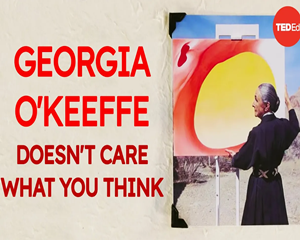A canvas drenched in sunset hues, colors radiating like flame.
这块画布沉浸在落日的色调中,像火焰放射光芒的色彩。
At first glance, this painting may appear to be an impossible, abstract image.
一眼看去,这幅画描绘的似乎是不真实的抽象影像。
But a closer look reveals the tender stems, lush petals and velvety texture of a Canna Lily.
但近一步观察,浮现在眼前的是美人蕉柔嫩的花茎、娇艳的花瓣和天鹅绒般的质感。
This metamorphosis of natural subjects into abstract geometry is commonplace in the work of Georgia O'Keeffe -- the revolutionary American painter and sculptor.
这种将大自然的元素转换成抽象几何的变形在这位划时代的美国画家、雕刻家--乔治亚·欧姬芙的作品中比比皆是。
But the magic behind this transformation remains just as elusive as the artist herself.
但这种变化背后的魔法仍如艺术家本人一样难以捉摸。
Born in Wisconsin in 1887, O'Keeffe spent her childhood plucking wildflowers and arranging fruits to paint.
欧姬芙1887年生于威斯康星州,童年时,她会临摹摘下的野花和摆放好的水果。
At seventeen, she moved to Chicago to study at the prestigious Art Institute.
17岁时,她搬去了芝加哥,在著名的芝加哥艺术学院求学。
Her teachers trained her to faithfully reproduce reality in the conventions of European masters.
她的老师们训练她依照欧洲大师们的传统,忠实地对现实进行再现。
Although she enjoyed the solitude and precision of this work, O'Keeffe felt little personal connection to it.
虽然这种作业的孤独与精准让她乐在其中,欧姬芙却几乎无法从中感受到与她个人的共鸣。
After moving to New York, she was increasingly drawn to the clean lines, striking composition and vivid colors of Japanese art.
在搬去纽约之后,她愈发被日本艺术干净的线条、醒目的构图与鲜活的色彩所吸引。
O'Keeffe soon found a teacher whose lessons inspired her to put those interests into practice.
欧姬芙很快找到了一位新老师,他的课程鼓舞她将这些兴趣投入实践。
Unlike her previous teachers, Arthur Wesley Dow urged his students to focus on more abstract representations of light, shape, and color.
与她之前的老师们不同,阿瑟·卫斯礼·道鼓励学生注重光线、形状与颜色这些更加抽象的表现形式。
These lessons manifested in O'Keeffe's first series of abstract drawings.
这些课程催生了欧姬芙的第一组抽象画。
Rendered in charcoal, they present a series of undulating lines, bold shading and billowing clouds.
这些画用炭笔绘成,展现了一系列波动的线条、大胆的阴影与舞动的云朵。
These drawings defy easy classification -- suggesting, but never quite matching, any specific natural reference.
这些画作无法被轻易归类--它们似乎在暗示特定的自然参考物,却从不会与之特别吻合。
Earlier European painters in the Cubist tradition had employed rigid geometry to abstract external subjects.
早期的欧洲立体主义画家会采用棱角分明的几何形状将外在的主体抽象化。
But here, O'Keeffe employed the shapes and rhythms of nature to capture her internal feelings.
但在这里,欧姬芙使用了自然的形状与韵律捕捉她自己的内在情感。
Experiments like these would soon become a cornerstone of an artistic movement called American Modernism.
像这样的实验很快就变成了“美国现代主义”艺术运动的基石。
Although no single style defines Modernist painting, its proponents shared a desire to challenge the realist traditions that dominated art education.
虽然现代主义艺术无法用单一的风格定义,它的倡导者们共同怀抱着挑战长期主宰艺术教育的现实主义传统的渴望。

Beginning in the late 1910's, Modernist painting often used geometric shapes and bold colors to probe the American psyche.
始于20世纪10年代末期,现代主义艺术常常使用几何形状与大胆的色彩来探索美国人的心理。
O'Keeffe threw herself into these experiments -- but she was reluctant to share her new work.
欧姬芙也投身于这些实验——但是她不情愿分享自己的新作。
However, when a friend sent her charcoals to the art dealer Alfred Stieglitz, he became entranced.
然而,当一位朋友将她的炭笔画寄给艺术商阿尔弗雷德·史蒂格利兹后,他立刻深深陶醉于她的作品。
In 1916, he arranged for a grand exhibition in New York.
1916年,他在纽约举办了一场大型画展。
This marked the beginning of O'Keeffe's career as a popular artist -- and a relationship that would lead to marriage in 1924.
这也标志着欧姬芙风靡画坛的艺术家生涯的开始--同时开始的还有一段于1924年修成正果的姻缘。
Marriage didn't diminish O'Keeffe's taste for solitude. She travelled widely to teach, and often retreated to paint for months at a time.
婚姻并没有磨灭欧姬芙对寂寞的钟情。她广泛游历进行教学,也常常隐居数月潜心进行创作。
Whether she was exploring the craggy canyons of Texas, the quiet forests of South Carolina, or the sun-bleached desert of New Mexico,
无论她是在探索德克萨斯州嶙峋的峡谷,南卡罗莱纳州静谧的森林,还是新墨西哥州烈日下的沙漠,
her creative process was based on ritual and close observation.
她的创作过程都是基于仪式感和细致的观察。
She paid meticulous attention to small details, and spent hours mixing paints to create exactly the right colors.
她会对小细节一丝不苟,还会花费数小时混合颜料,以调出最为恰当的色彩。
When she found the perfect hue, she'd record it in her ever-growing collection of handmade color cards.
当她找到了完美的颜色,她便会将其记录在自己日益丰富的手工色卡收藏里。
O'Keeffe also experimented with perspective to celebrate objects that were often overlooked.
欧姬芙还尝试通过不同的视角去赞美那些往往被忽视的事物。
In "Rams Head with Hollyhock," she places a weathered skull and a delicate flower high above the hills below.
在《公羊头与蜀葵》中,她把一枚沧桑的头骨和一朵纤弱的花高高置于群峦之上。
This massive skull overshadows the landscape, casting both the skeleton and the mountains in a new, eerie light.
巨大的头骨令景观相形见绌,将骷髅与群山都笼罩于新奇诡谲的氛围中。
The public was captivated by her unique perspective and secretive behavior.
欧姬芙独特的视角和隐秘的作风令公众深深着迷。
She was particularly praised for her massive flower paintings, ranging from fiery poppies to ghostly calla lillies.
尤其是她饱受赞誉的巨大花卉画,从烈焰般的罂粟花到鬼魅般的海芋。
Stieglitz and other critics of the time were infatuated by Freudian psychology, and were quick to link these paintings to female genitalia.
史蒂格利兹和当时的其他评论家沉迷于弗洛伊德心理学,急于将这些画作和女性生殖器联系在一起。
But O'Keeffe dismissed such interpretations.
但欧姬芙驳回了这种诠释。
She resented the male gaze that dominated the art world, and demanded her work be respected for its emotional evocation of the natural world.
她憎恨主导艺术界的男性凝视,并要求他人尊重自己作品中对自然界的情感唤醒。
Eventually, O'Keeffe settled down in New Mexico, near one of her favorite artist retreats.
最后,欧姬芙在新墨西哥州定居,邻近她最爱的艺术家隐居地之一。
In her 70's, her eyesight began to fail, but she continued to mine the landscape's mysteries in new, tactile mediums.
年过七旬的欧姬芙,视力渐渐衰退,但她仍继续用新的触觉媒介挖掘这片土地的神秘之处。
O'Keeffe kept creating until her death at 98, and is remembered as the "Mother of American Modernism."
直到98岁辞世,欧姬芙还一直在创作,并作为“美国现代主义之母”被世人铭记。
Decades on, her work retains its wild energy -- and O'Keeffe her personal mystique.
历经数十载,她的作品依旧留存着其狂野的能量--正如欧姬芙保留了她的神秘感。


